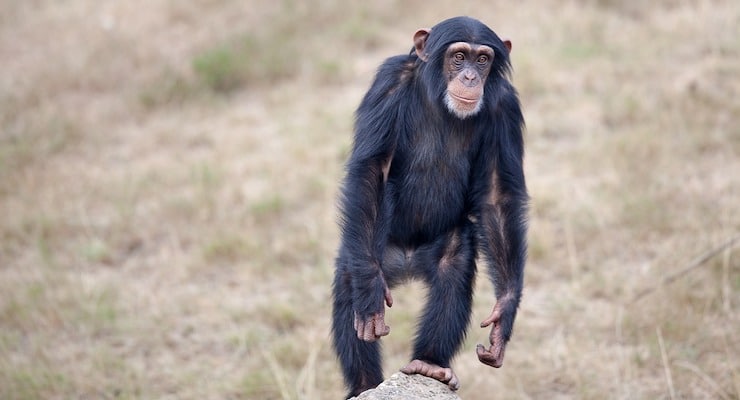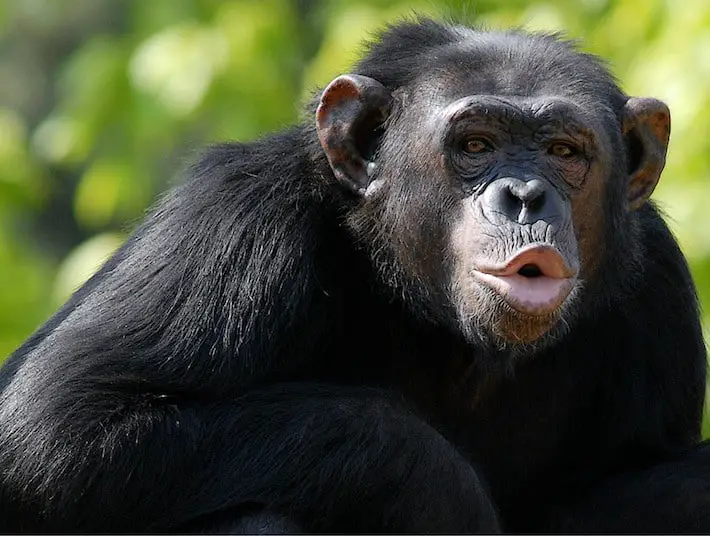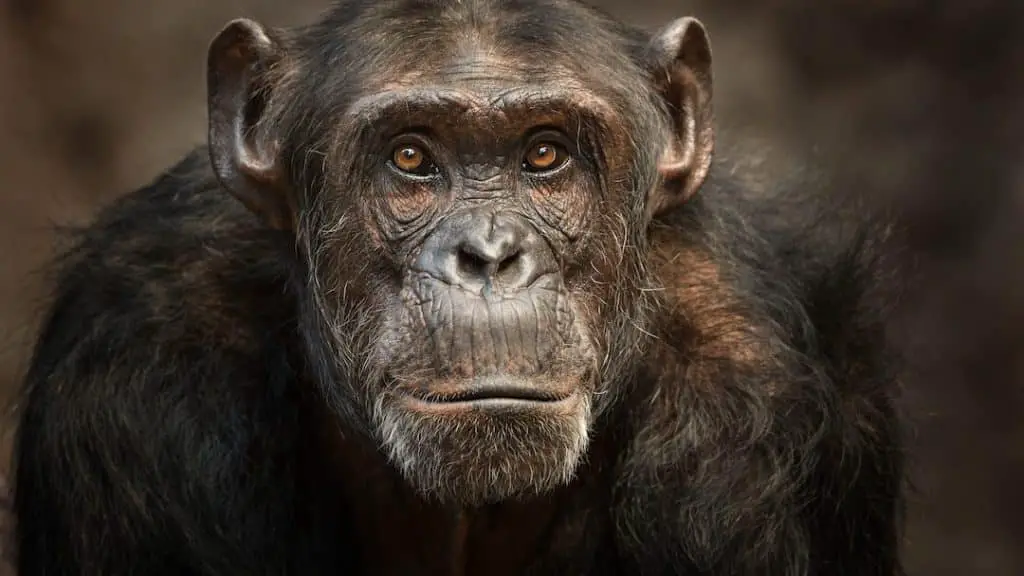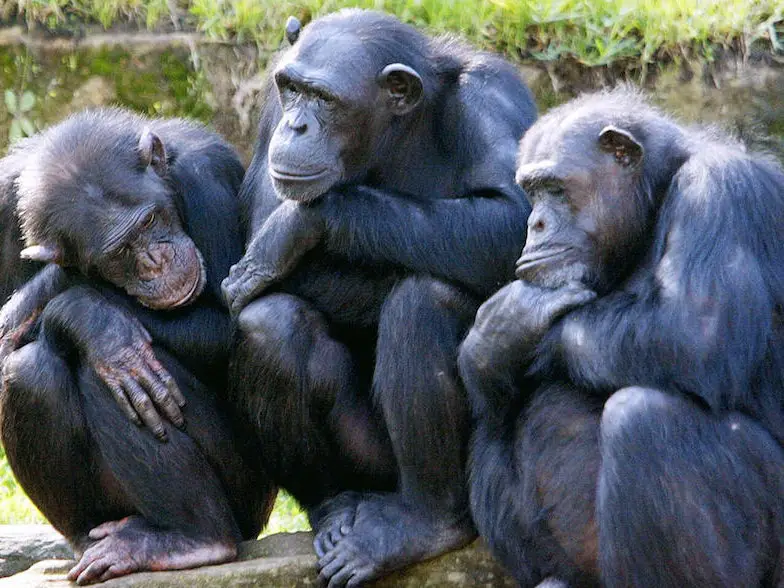Among nonhuman mammals, hostility between rival groups is quite widespread, but rarely leads to death. Frequent fights between males are very often limited to intimidating behavior. While it is certainly scary, it is rarely fatal. However, there is one exception: our closest cousins, the chimpanzees! Ethological studies have shown that animals are capable of forming complex political alliances. The English primatologist Jane Goodall made an important discovery on this topic when she revealed an unsuspected dark side in chimpanzees.
The behavior of chimpanzee colonies
In 1974, when Goodall was studying the behavior of chimpanzee colonies in Gombe, in Tanzania, observed a social division between two groups in one of the communities. The first group, called the Kasakela community because it occupied the northern part of the park of the same name, was made up of eight adult males and twelve adult females, as well as their young. The second group, called the Kahama community, consisted of six adult males, one adolescent male, and three adult females.
Hostilities began in an extremely violent manner when a male from the Kasakela group killed Godi, a male from the Kahama group. Kasakela rage continued to plague the Kahama for the next four years, during which six more males were killed. As for the Kahama women, two have disappeared and three have been beaten by a gang of violent males.
The end of this “four-year war” led the Kasakela community to conquer the Kahama territory. It was a short-lived victory, however, as another community of chimpanzees living nearby managed to scare off the Kasakela.
Goodall recounted her poignant memories of this war in her memoir “Through a Window: My Thirty Years with the chimpanzee of Gombe”. He recalls: “For several years I struggled to come to terms with this new knowledge.
Often, when I woke up at night, horrible images would pop into my mind unexpectedly: Satan [una delle scimmie], who cupped his hand under Sniff’s chin to drink.” blood pouring from a large wound on his face; old Rodolf, usually so benign, standing up to throw a four-pound stone [1,8 chilogrammi] against Godi’s prostrate body, Jomeo tearing a strip of skin from Dé’s thigh, charging; and striking, again and again, the wounded and trembling body of Goliath, one of his childhood heroes.”

Jane Goodall isn’t the only one haunted by bloody images of chimpanzee killings. American researchers have reported similar scenes of violence among chimpanzees in Uganda’s Kibale National Park. The ferocious battles of these primates were unleashed by coalitions of adult males, with the sole aim of extending their territory. The areas in which the fighting took place corresponded to the lands conquered by force.
Are these primates really at “war”? If we define war as organized lethal violence against members of another group, then the answer is clear. Like humans, chimpanzees have the ability to wage war. Before the fighting began in Kibale National Park, the males carried out systematic patrols.
The location of the corpses confirms the importance of the territory as a motivation for the fight: these chimpanzees had breathed their last in this coveted neighboring area. These wars were filled with the terror of infanticide between rival gangs, atrocities also committed by humans.
Three such attacks were reported by anthropologists from Ohio University and the University of Michigan in the International Journal of Primatology. The researchers recounted how on several occasions, while on patrol, adolescent and adult males from the Ngogo chimpanzee community attacked children from a rival gang, killed them and cannibalized one of them.
While there are cultural disparities between our ways of waging war and those of chimpanzees, some similarities are striking. Both humans and chimpanzees ensure that murders can be committed by multiple individuals without much risk to the attackers, and both have motivations for these murders (conquest of territory, hierarchical position, access to resources, etc.). Indeed, some researchers are now using the “chimpanzee model” to explain the emergence of warfare among humans.
Chimpanzee aggression does not only manifest itself when faced with a rival community. American anthropology professor Jill Pruetz and her team from Iowa State University recounted the murder committed in 2013 by several males of a member of their own group in Fongoli, Senegal.

Although the researchers did not witness the massacre as it took place, which occurred in the darkness of night, they heard the blood-curdling screams. In the morning they discovered to their horror the corpse of Foudouko, a 17-year-old former alpha male, who had been stripped of his status in 2007 by a gang of young chimpanzees.
Condemned to exile and isolation, the pariah regularly attempted to rejoin the group, establishing himself as dominant, which the new alpha males did not like. The research team hypothesized that if his entry had been more subdued, the outcome likely would not have been fatal.
These rare but incredibly cruel lethal attacks recorded among chimpanzees were not linked to the presence of humans near their communities (as some scientists had assumed) but to hierarchical tension within the group and probably to intense competition for access to females.
What disturbed scientists most was the way the gang treated Foudouko’s body the day after his death. Most likely to ensure that they no longer had anything to fear, the murderous gang dragged the body on the ground, smelled it repeatedly, tore off its genitals, bit it all over, tore off its flesh and… ate it!
Murder and cruelty are therefore not the exclusive prerogative of Homo sapiens. And even the animal world has not finished surprising us.
Chimpanzees use military tactics never before seen in humans
Scientists have found that chimpanzees use an ancient military tactic to make decisions and avoid potentially fatal clashes with rival groups.
Researchers observed two communities of Western chimpanzees ( Pan troglodytes verus ) in Africa climbing hills to keep watch over each other, much like reconnaissance missions used by the military. They then used that information to decide when to enter the disputed territory.
Many animals seek danger in their environment, but this is the first time scientists have documented a nonhuman species making elaborate use of elevated terrain to assess risk in a territorial conflict, according to the new study, published Nov. 2. in the journal PLOS Biology.
“It really demonstrates this ability for metacognition, so the ability to reflect on your knowledge and act on what you don’t know to get more information,” said lead author Sylvain Lemoine, assistant professor of biological anthropology at the University of Cambridge.
According to a statement released by the University of Cambridge, the use of elevated terrain is one of the oldest military tactics in human warfare.

Chimpanzees live in communities that compete for space and resources, and their normal behavior involves coordinated aggression, including occasional killing.
The boundary between chimpanzee communities is not set in stone, and their daily presence in an area is what matters, Lemoine said, adding that it is like living in a “constant state of low-intensity, small-scale warfare.” stairs”.
The new study looked at two nearby chimpanzee communities monitored by the Taï Chimpanzee Project, a research and conservation project based in the Taï National Park in Côte d’Ivoire. The team, along with students and local assistants – unnamed in the study – followed the chimpanzees for 8-12 hours a day between 2013 and 2016, collecting GPS and behavioral data.
The data showed that the chimpanzees were more likely to climb hills when traveling towards the edges of their territory rather than towards the centre. According to the study, while on these hills, they rested peacefully instead of engaging in activities that would hamper their ability to listen.
Chimpanzees in the study were more likely to advance from high ground into disputed territory when their rivals were far away, suggesting they used hills to avoid conflict. However, they can also use them to find an opportunity to attack.

Lemoine noted that when members of two communities meet, the balance of power – the numbers on each side – is an important factor in determining whether one side escalates violence. Chimpanzees appear to be able to weigh the costs and benefits of involvement, and hills help them do so.
“They use the higher points to find the right conditions where they can take the risk – or not – of attacking,” Lemoine said.
The new study only looked at chimpanzees in Taï National Park, but Lemoine told LiveScience that he assumes other chimpanzees also use this tactic, depending on the terrain.
In the statement, Lemonie claims that the complex cognitive abilities that help chimpanzees expand their territory would have been favored by natural selection, potentially suggesting that these warfare tactics are rooted in evolution.
“We are perhaps seeing traces of small-scale proto-warriors that probably existed in prehistoric hunter-gatherer populations,” he said.
#Chimpanzee #wars #taught #murder #cruelty #human #traits